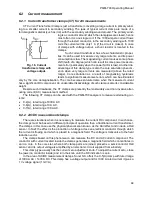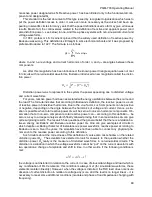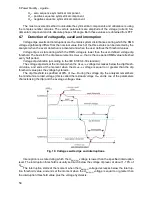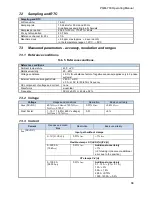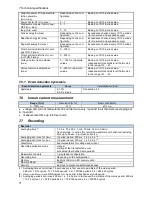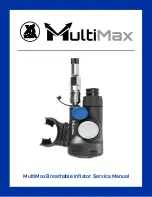
PQM-700 Operating Manual
56
6.5.1 Harmonics characteristics in three-phase system
In three-phase systems, the harmonics of given orders have a particular feature which is shown
in the table below:
Order
1
2
3
4
5
6
7
8
9
Frequency [Hz]
50
100
150
200
250
300
350
400
450
Sequence
(+ positive,
– negative,
0 zero)
+
–
0
+
–
0
+
–
0
The row “Sequence” refers to the symmetrical components method which allows the resolution
of any 3 vectors to three sets of vectors: positive sequence, negative sequence and zero sequence
(more in the part related to unbalance).
Let us use an example. Assuming that a three-phase motor is supplied from a balanced, 4-wire
mains (RMS phase-to-neutral voltage values are equal, and angles between the individual funda-
mental components are 120
each).
Sign “+” in the row specifying the sequence for the 1
st
harmonics means the normal direction of
the motor shaft rotation. The voltage harmonics, for which the sign is also “+” cause the torque
corresponding with the direction of the fundamental component. The harmonics of the 2
nd
, 5
th
, 8
th
and 11
th
order are the opposite sequence harmonics, meaning that they generate the torque which
counteracts normal motor direction of rotation, which can cause heating, unnecessary energy
losses, and reduced efficiency. The last group are the zero sequence components, such as the 3
rd
,
6
th
and 9
th
, which do not generate torque but flowing through the motor winding cause additional
heating.
Based on the data from the table, it is easy to note that the ,
–, 0 is repeated for all
successive harmonic orders. The formula which links the sequence with order is very simple, and
for k being any integer:
Sequence
Harmonic order
“+” positive
3k +1
“–” negative
3k
– 1
“0” zero
3k
The even order harmonics do not appear when a given waveform is symmetrical in relation to
its average value, and this is the case in majority of power supply systems. In a typical situation, the
measured even order harmonics have minimum values. If we consider this property, it turns out that
the group of harmonics with the most undesirable properties is the 3
rd
, 9
th
, 15
th
(zero sequence),
and the 5
th
, 11
th
, and 17
th
(negative sequence).
The current harmonics which are multiples of 3 cause additional problems in some systems. In
4-wire systems, they have a very undesirable property of summing up in the neutral conductor. It
turns out that, contrary to other order harmonics, in which the sum of instantaneous current values
is zeroed, the waveforms of these harmonics are in phase with each other which causes adding of
the phase currents in the neutral conductor. This can lead to overheating of such conductor (partic-
ularly in the distribution systems in which this conductor has a smaller cross section than the phase
conductors, and this was widely practiced until recently). Therefore, in systems with non-linear loads
and large current distortions, it is now recommended that the cross section of neutral conductor is
larger than that of the phased conductors. In the delta systems, the harmonics of these orders are
not present in the line currents (provided these are balanced systems), but they circulate in the load
branches, also causing unnecessary power losses.
Character of individual harmonics as shown in the table is fully accurate only in three-phase
balanced systems. Only in such systems, the fundamental component has the exclusively positive
sequence character. In actual systems, with some degree of supply voltage unbalance and the load
Summary of Contents for PQM-700
Page 85: ...85 Notes...



